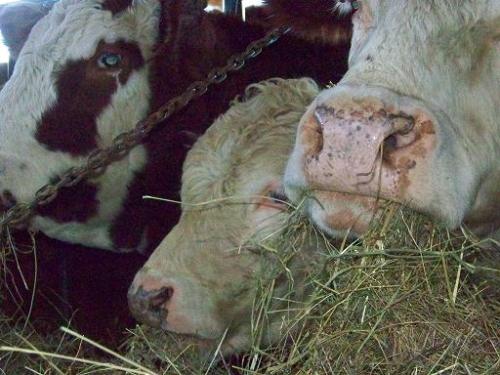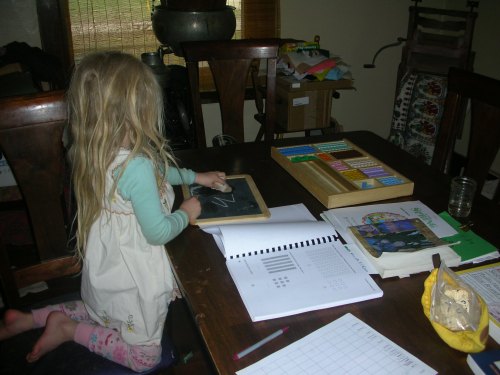This is part of a series we decided as a group to do. I understand a number of readers where interested in how we all spend our days.
I start out my morning at about 7 everyday. I rise, like clockwork (and without one) to say goodbye to my son as he goes off to school. I am an early riser compared to the rest of my family, though I am a slow starter. I have always risen by 7:15 at the latest, late nights and weekends included except for a few rare occasions. I do unfortunately have the worst time making it anywhere consistently before 9 – to the frustration of my family when I have to drive them somewhere. However…I work at home so I don’t have to be anywhere before then generally – super lucky me.
In the spring, before I leave my room in the morning, I turn on my grow lights on the plants that I still have under lights. I don’t have another room or area to designate for my plant starting but I would like to eventually. Having it in my room does make it easy to remember to turn on the lights without a timer though—because they are right there in my sitting area. And off in the evening since I wouldn’t be able to sleep.
Besides using the lights, I also place some of the plants outside if it will be at least in the mid 40s all day. I move things like pak choy, kale and even tomato starts out side to the patio to spend the day –watering them if I find I missed some the night before. The tomatoes don’t go out if it will only be in the 40s though—I put them out only when it will be a bit warmer than that.
Afterwards, I go upstairs and start my tea water and my computer if I have time. While I drink my tea I try to take the time to check my email or post things to my blog(s) if I don’t have to be somewhere in a hurry. Sometimes instead of checking email I pick up from the night before. Pans that may have been soaking from dinner, clothes left out, papers/books/magazines may get organized —maybe even start some laundry if I need too. After tea, I get dressed, wash my face and brush my teeth and then get started on the “real” part of the day.
Now here is where it diverges. This spring we no longer have sheep for the first time in a long while. If this was a sheep spring I would already have gone outside—before my plants, tea, tidying and computer—to check on any ewes that may have lambed. Lambing would have started somewhere by mid March for us and gone on, depending on number of ewes and when bred, up to the first of May usually. If I had a ewe that had lambed I would have then spent time bringing them into a pen in the barn so that I could watch them until the next day, longer if I had triplets or one had a rough start on a cold night. I might help dry them off if they were still damp and then feed, hay and water mom, while taking just a bit of time to watch them interact before going in. If it was an older ewe I would spend less time watching interactions than a first time ewe. First time ewes are a bit flaky sometimes. They are kind of like teenagers—their brain doesn’t always click quite logically and you have to focus them. During the day I would have also come out periodically to re-check on them and spent some time just enjoying them. At this point I would usually be taking a number of pictures too.
This year we no longer have sheep, though we do now have a milk cow (technically she is a bred heifer but we’ll call her a milk cow for simplicities sake). We don’t know exactly when she will calve—sometime in the next two months at the most I believe. Maybe sooner. The new routine now is to stay in line with how we will milk. So…I have my tea, wash and brush and then go out to water, hay and give a tad bit of grain to my Girl (that’s her name) and tie her and brush her all over. I also touch and handle her udder like I am prepping her for milking. I then walk her around, starting/stopping and turning at points so that she will learn some commands. I also want her to understand that when I lead her she will go somewhere she will like to be. Each day I spend a bit more time walking her than I did the first couple of days we had her, but I never go beyond say 10 to 15 minutes. I would rather come out more than once during the day for practice than to wear her out with one lonnnnggg practice session.
When I am done I free her into the pasture she will graze in that day— which is where she wants to go instead of eating that “nasty” old dried grass that I leave for her to munch during the night. I want, and try, to be out there a bit after 8 since my milking routine will probably be 8:30 ish. I have not yet made it around to picking up her feet but I stroke her legs too while I am grooming her. All this is to get her used to us because we want her to be easy to milk and easy to handle. Sticking with a routine is the way to do it. Routines are calming to cows. They like consistency best. They like the same place, same time, same routine. Kind of fuddy-duddy-ish isn’t it?
After messing with the cow I go in and feed the dog along with myself if I feel like breakfast that morning. I am not a big breakfast eater and have a tendency to stick with the same thing over and over — so sometimes I just skip it because I am bored of eating it. Actually bologna sandwiches, fritos and dr pepper seem like a great breakfast to me—or maybe tuna—but I watch the health aspect of my foods a bit better than that so I rarely ever eat something like that in the morning (or even the afternoon).
Afterwards the dog and I go out to feed the birds (ducks and chickens) and check on the pigs and give them some breakfast if for some reason we didn’t get them dinner the night before. Sometimes they have huge amounts of scraps during the afternoon depending on what I am cooking or doing and so they don’t always get dinner. If that is the case…by morning they are “squealing hungry” and need a snack to tied them until later. My pigs are guinea hogs, a somewhat uncommon and rare breed of pig, and this is our breeding pair. Since we are not fattening them for slaughter we have to help them watch their weight — which is why they don’t get fed quite the same as a hog for slaughter would. They, like all of us, would like to eat like they are going to slaughter though 🙂
Since the pigs and birds are right near the garden I will then usually work there depending on what needs to be done and how the weather is. Some of the things I might do are:
*Hand pull or hoe weeds
*Mow
*Mulch plants
*Plant plants
*Start seeds that will be started outside
*Prep beds that haven’t been prepped—like turning, tilling, making rows or just lightly weeding.
*Sometimes I spread fertilizers —always organic —into new beds I will soon plant or side dress growing younger plants.
* Uncover if I have been covering them because of the weather
*Put up trellis, netting or fencing —depending on what will be planted—to get ready for taller growing plants not yet in like beans and tomatoes. Since they don’t always follow the peas I have to trellis new spots for them
*Harvest anything ready to harvest (which right now is nothing really except an occasional leaf or two)
*Prune or trim things I have missed
*Tighten wire trellising around permanent beds or repair it if it needs it. I have permanent cross T posts with wire through them to hold up my asparagus and raspberry. Some of the Ts had been coming lose and needed repair since the cross bar screws had come lose. Instead of tightening them as I had been doing I decided to replaced them all with threaded rod all the way through the main post and cross T. Hopefully this will hold them on better and I will not need to re-tighten them each year as I had been – on any of the beds like that.
* Water if we have not had enough rain –especially on the seed beds. I like to water my seed beds in the morning and the evening. I think they stay moister that way and sprout better.
By the time I do all that, along with other flim flamming in the yard, it is usually around lunch time. Usually I come in and eat lunch. Hopefully leftovers from dinner since they are more reasonably priced. If not though (maybe I hated what I made or it was so good it all got eaten) I will run down occasionally and get something from one of the local diners and run errands at the same time. If I eat at home I will finish the household stuff I didn’t in the morning. Things like clean up, do laundry, plan what to have for dinner if we are eating here and thaw it, read through my mail/pay bills/budget and handle any office work I might need to do for the household. I also take the time to shower if I need to and get “spiffy’d” up — unless I will be going out to do something really dirty again…then I wait until later. If I eat out I will run errands like go to the feed store or grocery store or even up to the mall if I need something from there.
By this point (usually about 3) I am a bit tired and I will sit and read or research things that we would like to know or need more info on while I have an afternoon tea. Relaxation time. By summer….I give up the afternoon tea since it is just to hot. If I don’t use the a/c it’s to hot to drink hot tea and if I am using a/c I feel like it is a waste to cool the house so I can drink something hot. Silly.
Before I know it the kid is home from school and it is time to start getting dinner ready and he and I will chat for a bit. Sometimes, if I have heavy or difficult tasks I will go out again with my free laborer to help me and finish whatever it is that I needed help doing. Like yesterday…he tilled down the cover crop of wheat for me so I can start prepping the bed for the sweet potatoes that will go there in about a month. Sometimes it’s digging holes for new fences (or digging out poles for a design change on the fence ) sometimes it’s cleaning out hay from the barn. In the case of the hay, with the sheep ,we cleaned out the barn only in the fall before the bad winter weather and in the spring right before lambing so it usually was a big pack and could get quite matted down. Very heavy and much easier with two or even three people to work it. Other things that need two people are hanging gates or moving heavy objects or big limbs. Sometimes if I am going to pick up something that I will have trouble loading or unloading without someone else to help — I will take my son with me. The list goes on of course–all things I am glad to have a helper for. One that even comes home early –or earlier than my husband anyway. My son is a fabulous worker. Working without complaint almost all the time. When I say something about that he always says it’s because I work beside him. He says he can’t have his mother look stronger than him.
Around 6 my husband gets home—usually. Then we eat dinner, clean it up and then sometimes run errands or work outside together or separately depending on what needs done and the weather. We don’t watch much t.v. Only about 4 hours total a week. I may go out and mow the pasture or work in the garden again and he will sometimes do things I know nothing about—like rebuild all the mowers and machinery I use while he’s gone but have no clue how to upkeep (and don’t want to know). Sometimes we go hang out with friends or talk over projects we want to accomplish over the next week or two or even month. Occasionally we’ll take off and go play pool or go to the movies together or even relax just watching our animals. As with all spouses we have goals to work toward and things we have seen and heard throughout the day to talk about and share.
Eventually it gets almost dark. We check on the cow and bring her in for the night around 7:30. Repeating almost the same thing we did in the morning. We may eventually leave her out but right now she is new and we don’t want her to get a bee in her bonnet because we aren’t handling her enough. Then we will go in and read or maybe play on the computer(s) for a bit. Sometimes watch a netflix movie or something like that. A few days a week I will do a small bit of yin style yoga while watching t.v or reading a magazine or book at this time of night. I find yoga has made a huge difference in how my back and shoulders feel since I began doing it consistently. I have always stretched because of an ongoing shoulder issue but added a more consistent yoga practice this last year and a half to my life and really enjoy it. I do also go once a week to a yang style power yoga class—which is fabulous and has really built up my strength.
Eventually…10:30 comes and I go off to my room. Before I go to bed I bring in my plants that have been outside if I haven’t already done it, water them if they need it and turn off the grow lights. If this was a sheep spring…I would walk the pasture first and check them all before coming in to go to sleep to see if any looked as if they would labor that night. If I thought one might I would bring her up to the barn so I could get up and check during the night. I have on just a few occasions had a ewe that needed help in the middle of the night but rarely. Better safe than sorry is my philosophy. Then I hit the pillows – like clockwork without the clock – and am asleep by 11 (typically).
As I read back over this it sounds like I “work work work” all day. However many of the things I do I don’t consider work. I actually like doing them. A lot. I know some people would never think of weed pulling or hoeing as fun, but I do not find them un fun and kind of like them. Of course doing it in the middle of a 95 degree day isn’t my favorite—but that’s why I try and do it in the mornings. Obviously some of the other things are more enjoyable (like the animals) but to me, my day is full of mostly pleasant things along with time to do whatever I want. And what I want just happens to be gardening and care of animals. So it works out…..typically 😀
Read Full Post »







































